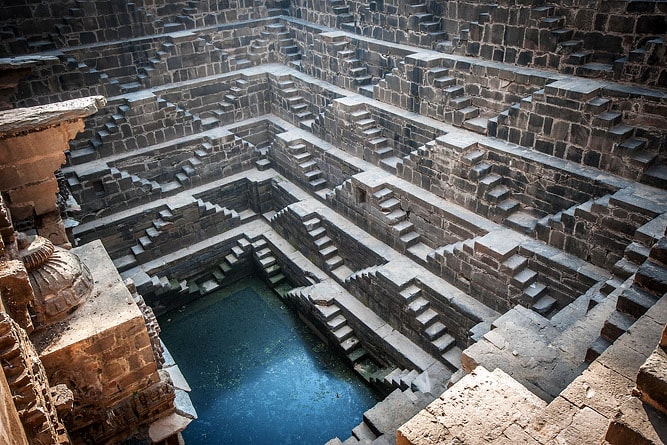Raniji ki Baori (Queen's stepwell)
Historic building in Bundi
could-see attraction
Opening hours: 9.30am-5:00pm
Address: Bundi Rd, Adisal Singh Colony, Gayatri Nagar, Bundi, Rajasthan
Ticket price: Indian/foreigner ₹50/200
Visit duration: People typically spend up to 30 min here


About Raniji ki Baori (Queen's stepwell), Bundi
Raniji ki Baori literally means the Queen's stepwell. This 300-year-old Baori is one of the largest stepwells in Rajasthan, with Chand Baori in Abhaneri (near Jaipur). Raniji ki Baori is a mediaeval marvel that displays meticulous workmanship. Long ago, it was used by townsfolk as a social assembly area and for religious celebrations.
The aesthetic architecture of the Raniji ki Baori reflects the uncompromising royalty of the Rajasthani Rajputs. The contents of its architecture showcase that the Rajputs were a patron of art and culture. The 17th-century Queen's stepwell is immersed in pure Indian architecture, unaffected by European or Islamic influence.
History of Raniji ki Baori (Queen's stepwell)
In 1699, Rani Nathavati Ji Solanki built the stepwell. She was the queen of King Rao Raja Anirudh Singh of Bundi. The Baori was named after this queen.
The tragic story that leads to the construction of the Baori makes the place close to the heart of people of Rajasthan. The first queen of the king was infertile. Another queen, Rani Nathavati Ji Solanki gave birth to a prince.
The first queen was envious and to appease her, Rani Nathavati Ji Solanki made the greatest sacrifice of giving her son away to the first queen. After this, to keep herself occupied Rani Nathavati Ji Solanki dedicated her life to the welfare of the people. This is why she initiated the construction of the stepwell.

Architecture of Raniji ki Baori (Queen's stepwell)
Raniji ki Baori is one of the largest of its kind. It is a massive three-storey stepwell which stretches across 260 feet x 40 feet with a depth of 151 feet. The gigantic gate or toran showcases mural works typical of Bundi.
Raniji ki Baori is a masterwork of the Hindu Rajput grandeur of Rajasthan. The structure is heavily ornate with exquisitely carved Toran Gates. The Queen’s stepwell exhibits sculptures of Gods and Goddesses along with murals and the stairs which are adorned with pillared cenotaphs.
You enter the Raniji ki Baori on the 2nd floor through the arch-shaped gateway. It displays murals on the ceiling. The initial stepwell has more than 100 steps.
The Baori has a narrow doorway with pillars on four sides which meets at the archway. The archway is embellished with murals, sculptures and ogee-carved stone brackets.
The gateway showcases intricate winding carvings on the pillars. The life-like statues of elephants, facing each other, at the top are carved from pristine white marble.
The last gate of the stepwell has sculptures of elephants at every corner. The use of elephant sculptures in abundance hints at how important these majestic beings were in ancient times of kings and queens. The Raniji ki Baori is carved with an ogee bracket design.
As you reach the staircase of the 2nd floor, you can perceive that both walls of the stepwell have temple-designed walls crafted with statues of Hindu gods.
As you descend the Queen’s stepwell you behold engraved figurines of standing Bahairawa, Ganesha, Saraswati, and Gajendra Moksh. It also showcases the avatars of Lord Vishnu and other incarnations like Varaha, Matsya, and Narsingh. However, the Turkish invaders destroyed the artworks.

Entry fee and timings
Raniji ki Baori is open from 9:30 am to 5:00 pm. The entry fee for Indian tourists is ₹50 and for foreign tourists is ₹200. For the camera, the charge is ₹100.
Facts and tips about Raniji ki Baori (Queen's stepwell)
- The inscriptions at the entrance gate illustrate the lineage of the Hada rulers of Bundi. The Baori also has a worshipping place on each of the floors.
- The Queen’s stepwell is under Archaeological Survey of India (ASI) protection and the site is maintained diligently, therefore damaging the historical architecture or any attempt of any prank can get you arrested.
- You can opt for combo tickets at Raniji ki Baori as the ticket will let you access 84 Pillared Cenotaph and Sukh Mahal.
How to reach Raniji ki Baori (Queen's stepwell)
Raniji ki Baori (Queen's stepwell) can be reached in less than 5 minutes by car from the Garh Palace and Taragarh Fort.
See location on Google Maps
Other attractions near Raniji ki Baori (Queen's stepwell)
- Garh Palace - 1.2 km
- Taragarh Fort - 1.2 km
FAQs about Raniji ki Baori (Queen's stepwell)
1. Is the entire site available for a tour?
The ground and first floor of the Baori are prohibited for tourists and hence remain inaccessible for tours.
2. Is there any eatery near Raniji ki Baori?
Yes, there are eateries just outside the Queen’s stepwell, where you can enjoy regional Rajasthani snacks.
3. Is the site wheelchair friendly?
The entryway is at a close distance to the main street but it is small therefore it remains inaccessible for a wheelchair.

